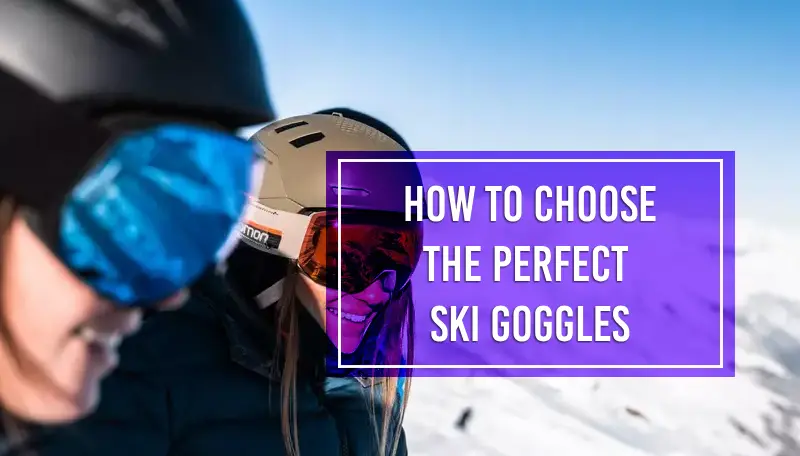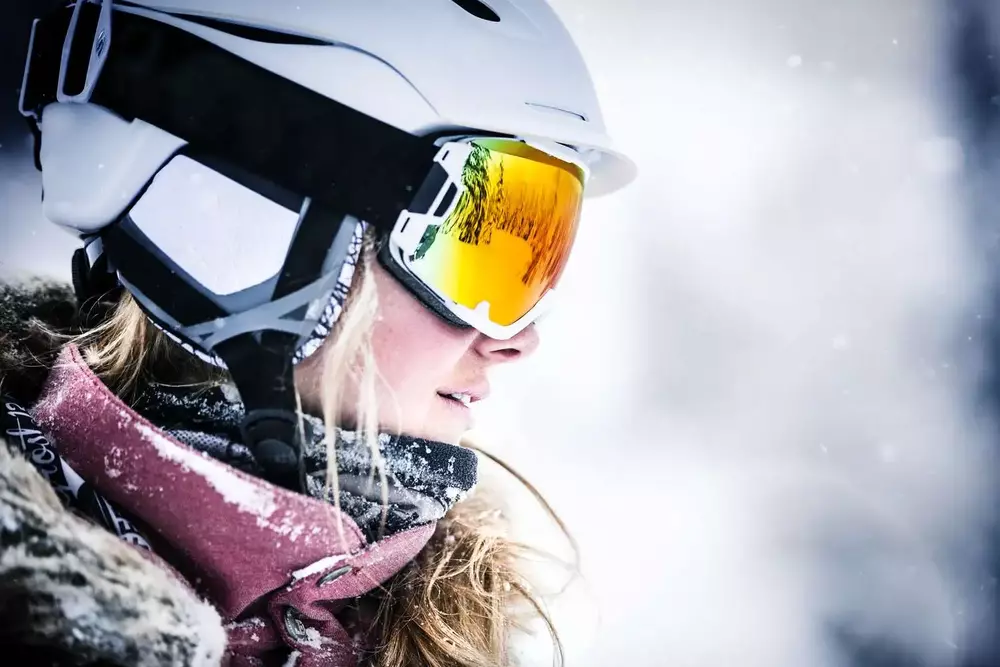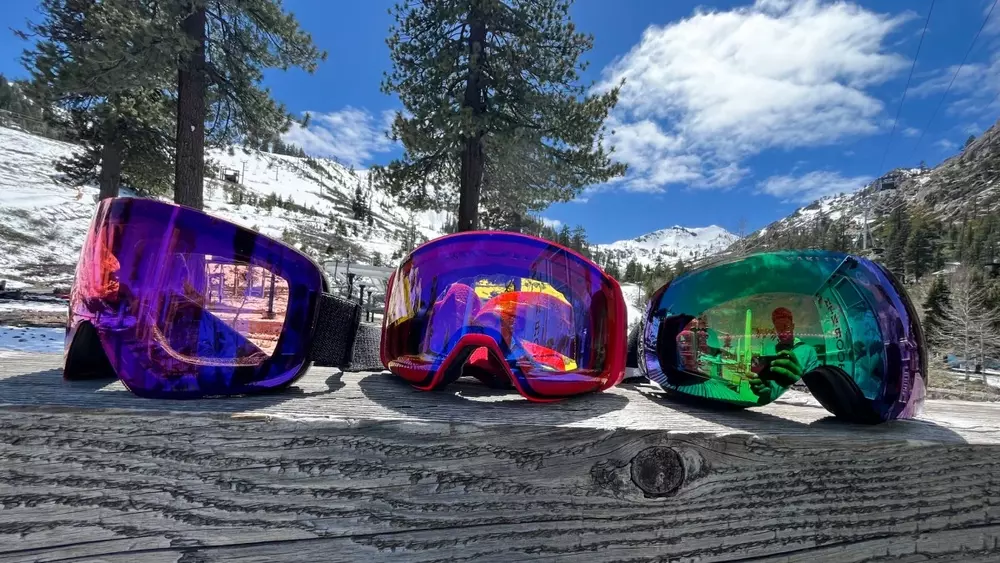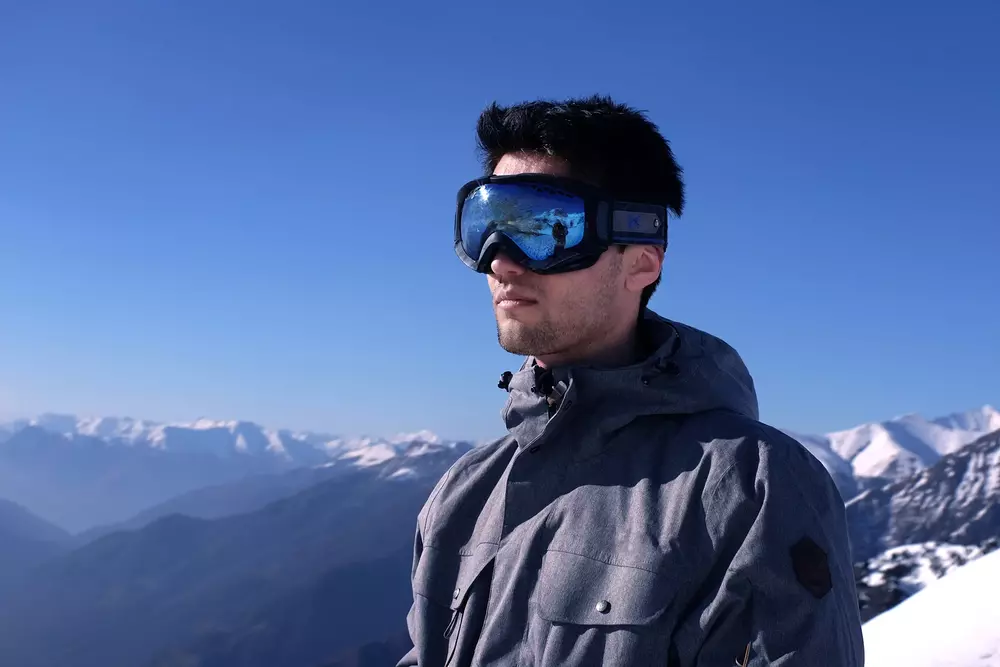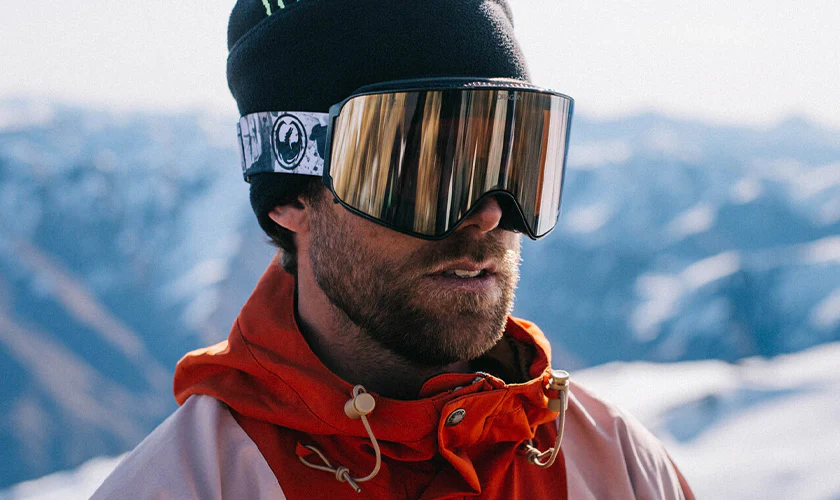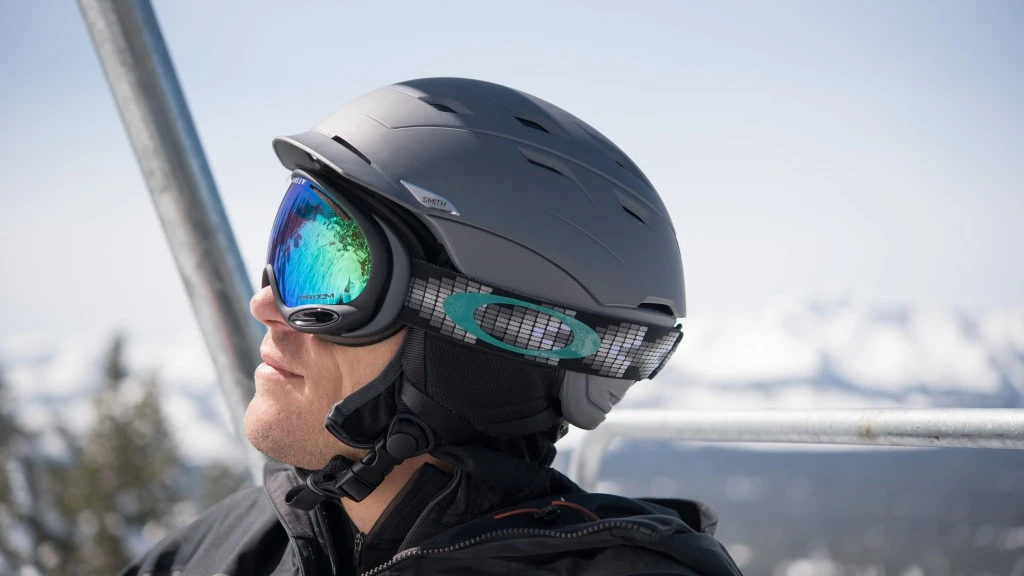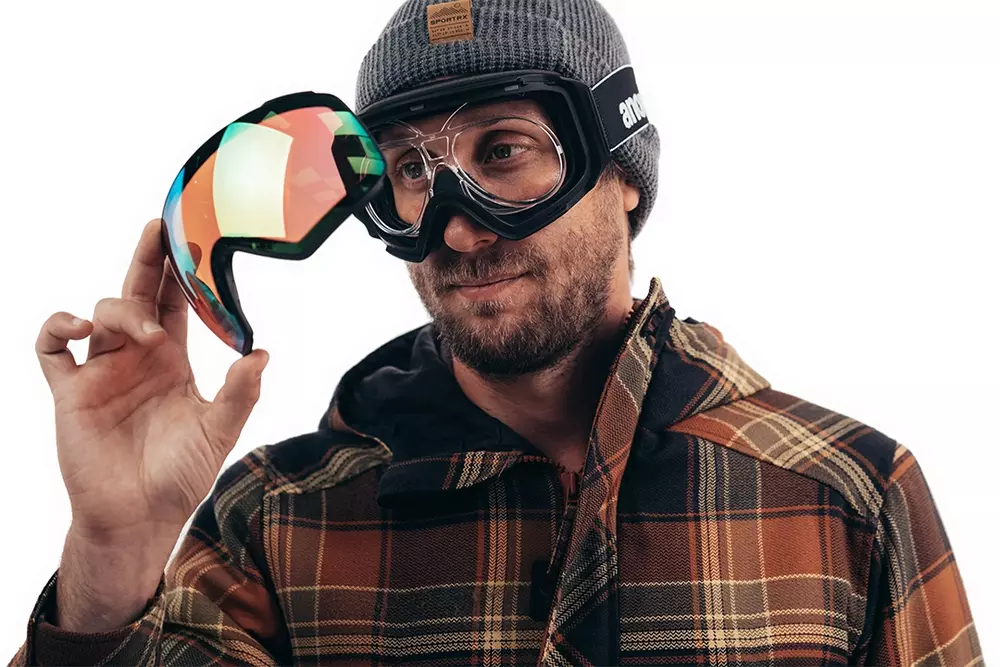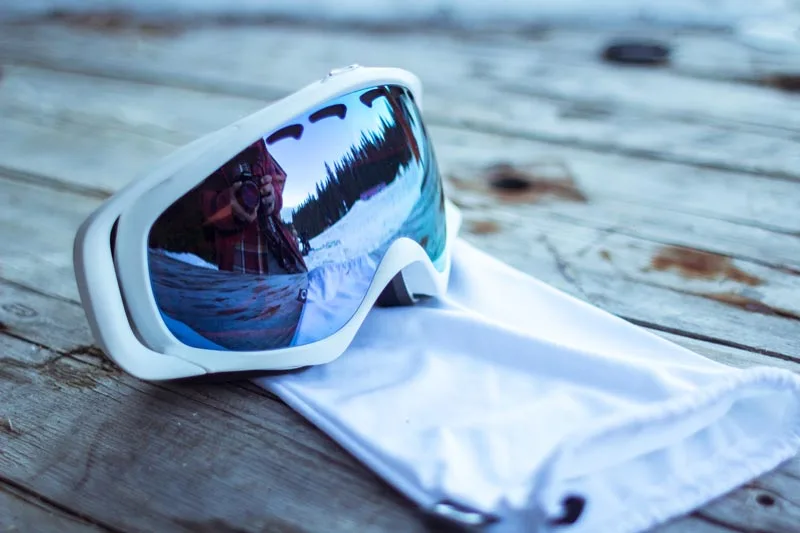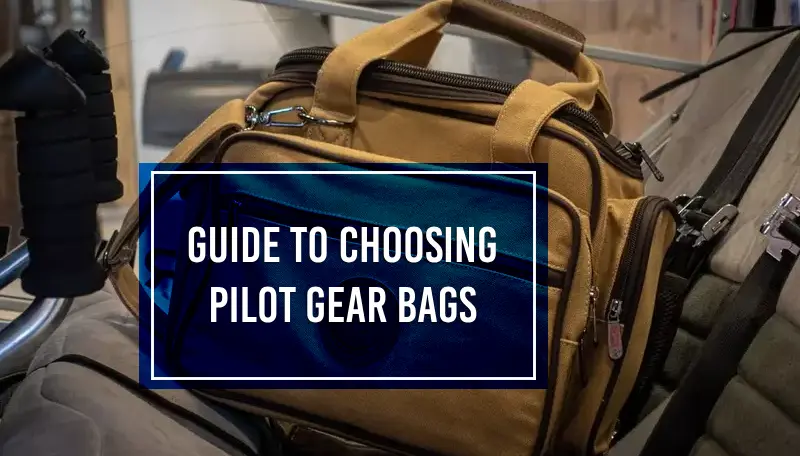Last Updated on
The iconic image of a skier comprises quite a few distinctive pieces of equipment. Skis and ski poles are probably the most easily recognized ones, but there are other items without which no skiing can take place. Ski goggles are one such item. They are often one of the most colorful pieces of skiing equipment that cannot but catch the eye. And also protect it. In this guide, we’ll cover why ski goggles are such an important piece of skiing gear, which aspects should be considered while choosing them and how to care for your ski goggles.
Table of Contents
Why Are Goggles Important
Ski Goggles Lenses
Cylindrical (Flat) Lenses
Spherical Lenses
Light Transmission
Ski Goggle Frames
Small Frames
Medium Frames
Large Frames
Factors to Consider
Ski Goggle Care and Maintenance
FAQs
The Importance of Choosing the Right Ski Goggles
Skiing down a hillside without a pair of ski goggles is an experience one is bound to remember. Not for a good reason, unfortunately. If there is not a cloud in the sky, your eyes will be assaulted by the glare from the snow. Should the weather be less forgiving, your eyes will feel the wrath of wind and snow. Not to mention that wind remains a constant factor in any weather (unless you somehow find a way to do skiing and snowboarding upwards).
All these trials are not easy to pass unequipped. Even if it’s possible to negate the glare with a pair of sunglasses, the same trick won’t work for wind and snow. If you want to preserve your clarity of vision and care about your eyes, a pair of ski goggles is a must. But there are a lot of them, and you don’t need too many. How do you choose? There are several factors you should consider, but it might be useful to first learn about the components of ski goggles. Just to get a better understanding of how they are all different from one another.
Ski Goggles Lenses
Lenses are the central piece of ski goggles. They are literally what you get goggles for, the component that protects your eyes from the perils of the weather. Since lenses play a pivotal role in the performance and safety capacity of your goggles, understanding the different types can help you make the most optimal choice. There are two primary classifications for ski goggle lenses: according to their form and light transmission capabilities.
Let’s delve into the details of the first classification. There are two major groups of ski and snowboard goggle lenses – cylindrical and spherical, each performing in a slightly different manner.
Cylindrical (Flat) Lenses
Cylindrical lenses, also known as flat lenses, are curved horizontally across your face but vertically remain flat. This gives the goggles a lower profile look and makes them generally less expensive than their spherical counterparts. However, this design usually causes minor distortion and glare because light isn’t passing through the lens at the same angle everywhere.
The flat vertical plane of cylindrical lenses somewhat limits peripheral vision and increases the likelihood of fogging due to the reduced volume of air between the lens and your face. Despite these drawbacks, many skiers and snowboarders appreciate cylindrical lenses for their affordability and performance in moderate conditions. So, if you are looking for a budget-friendly option, this is the way to go. Just be prepared for the road to become a bit foggy with time.
Spherical Lenses
Spherical lenses curve both horizontally and vertically around your face. As a result, the goggles sport a slightly bubbled look, though they skirt the contours of the face more naturally. This design also mimics the shape of the human eye and allows for a wider field of view, especially in the periphery.
The curved nature of spherical lenses allows for a more effective reduction of glare and distortion. This is because light enters the lens at the same angle no matter where it hits, providing a more accurate and clear visual experience. Furthermore, the increased volume of air between the lens and your face in spherical goggles helps reduce fogging.
While spherical lenses are often more expensive than cylindrical ones, their superior performance in terms of improved peripheral vision, reduced glare and distortion, and less fogging make them a true hit among long-time winter sports enthusiasts.
Light Transmission
You must have noticed how ski goggles are always very colorful, at least in terms of lenses. But that’s not because goggle manufacturers unanimously decided to make them stand out against the snow. Color and tint play a significant role in ski and snowboard goggle performance. The lens color filters light differently and can improve your visibility in certain light conditions or remain somewhat unhelpful if chosen poorly. So, it’s not as much about which color suits your skiing suit, but rather what the weather and lighting conditions are.
For low light and low visibility situations like when it’s snowing, foggy or in flat light, lenses with yellow, rose, or blue tints are ideal. These lenses allow a high percentage of visible light transmission, typically between 60-90%, enhancing contrast and visibility. They are basically better at transmitting light which is pretty helpful if there isn’t too much of it.
On bright and sunny days with high visibility, darker lenses in black, gray or gold tints are preferred. These often mirrored lenses have a lower VLT percentage, usually between 5-20%, thus boasting decreased light transmission and minimizing glare.
Interchangeable Lenses
While the choice between cylindrical and spherical lenses is almost entirely determined by the funds you are already to spend, things are not so easy with color. The weather may change, you see, and so may lighting conditions. Does that mean you need to buy several pairs to be prepared for everything? Not necessarily. Goggles with interchangeable lens systems are a much more versatile option. They allow you to quickly swap out lenses to adapt to changing light and weather conditions. Now, such goggles usually come at a higher price, but such a cost is not ungrounded. You can conveniently fit several pairs into one, sparing yourself the trouble of needing multiple pairs of ski goggles.
Additional Ski Goggle Lens Technologies
The two main classifications doesn’t cover all the ways in which ski goggles can be differentiated from one another. There are a bunch of other traits that are present in one pair and may be lacking in another. Here’s a short list of such traits.
UV Protection
Ultraviolet (UV) protection is a standard feature in most contemporary ski goggles, even budget-friendly ones. The higher in the mountains you go, the closer you are to the sun. It may seem like a minor difference at a cosmic scale, but sun rays are more potent in the higher altitudes. A pair of goggles with 100% UV protection (which is what most of them offer) stand as a shield that won’t let your retinas get damaged.
Mirrored Lenses
We mentioned that goggles with a low light transmission rate are often mirrored. That’s because mirrored lenses feature a reflective coating that reflects more light than a non-mirrored lens. That means less light entering your eyes, less glare and more visual clarity. Plus, mirrored lenses give your goggles a cool, aviator aesthetic, which also shouldn’t be overlooked.
Polarized Lenses
Glare usually comes as a minor inconvenience, but for skiers and snowboarders, it is one of the major hindrances. Not only because it makes it harder to see, but also because the glare from snow is more intense than the glare from the sun. Polarized lenses work as vertical light filters, cutting glare more effectively than standard mirrored lenses. They offer superior contrast and definition, while also reducing eye fatigue and strain.
Double Lenses
The design of double-lens goggles creates a thermal barrier that counteracts fogging much better than single-lens one does. This technology has become a standard in all new ski and snowboard goggles so you are not too likely to buy a pair featuring a single-lens-design. But they haven’t gone extinct, so make sure to double-check, out of harm’s way.
Anti-Fog Coating
To further combat fogging, goggle manufacturers apply a hydrophilic chemical treatment to the inside of the lenses. This coating significantly slows down the accumulation of moisture, thus reducing the likelihood of fogging.
Ski Goggle Frames
Lenses are the central functional piece of ski goggles, but they themselves offer little value to a sports enthusiast. Without a frame, lenses are just pieces of polycarbonate with great potential but little use. Apart from granting the ability to be worn, the frame also contributes to the general performance of ski goggles. Their main responsibility is to ensure a comfortable fit, but they are also tasked with not letting the snow through. The classification of ski goggles is pretty simple: it is based on their size, or, rather, the size of your head.
Small Frame
Small-frame ski and snowboard goggles are specifically designed to fit kids, youth, and adults with smaller faces. They provide a snug fit, ensuring that the goggles stay in place even during rigorous activity. Despite their compact size, small-frame goggles do not compromise on features, often offering the same high-quality lenses and anti-fog technology as larger models.
Medium Frame
Medium-sized frames are the most common and versatile, fitting a wide range of people. They are essentially unisex, with variations in color schemes and shapes to cater to different tastes and needs. Medium-frame goggles offer a comfortable fit for most skiers and snowboarders, providing ample field of view without being overly bulky.
Large/ Oversized
Large or oversized frame ski and snowboard goggles are designed to provide more peripheral vision, thanks to their larger frame size. This wider field of vision can enhance your skiing or snowboarding experience, allowing for better awareness of your surroundings, which is particularly useful in crowded or tree-lined runs. However, it’s important to note that some larger goggles may not be compatible with all helmets, so checking for compatibility beforehand is essential. Despite their size, these goggles should still provide a comfortable fit without feeling too loose. They are suitable for individuals who prefer a wider lens and enhanced visibility, especially snowboarders who need to keep track of a broader area while performing tricks.
Other Factors That Influence the Fit of Ski Goggles
It might seem like there is nothing more to ski goggles apart from lenses and frames. Sometimes it’s true, but sometimes it’s not. There can be other elements that contribute to the general performance of the ski goggles, mostly its fit.
Straps
Straps on ski and snowboard goggles serve the purpose of keeping the goggles securely in place. They should be easily adjustable to accommodate various head sizes and to ensure a snug, comfortable fit. Wider straps are often preferred as they distribute pressure more evenly across the back of the head, reducing the risk of discomfort or the goggles slipping off. Straps should also be durable and able to withstand cold temperatures without losing their elasticity. Some goggles feature silicone strips on the inside of the strap to prevent slippage on helmets or beanies.
Face Foam
The face foam on goggles serves to cushion the frame against the face, providing a comfortable fit while also sealing out wind and snow. It should mold to the contours of your face without creating any pressure points. High-quality goggles often use multi-layered foam, which offers superior comfort and a better seal. A poorly fitting foam will let in cold air and snow and even increase the likelihood of the lens fogging up, which is something you definitely don’t need.
Helmet Compatibility
However great a pair of goggles might be, it won’t be of much use if it doesn’t fit well with your helmet. Helmet compatibility is pivotal: you can’t ski without either of them, so you better make sure the two go well together. Goggles should sit flush against the helmet without leaving any gaps where wind or snow can enter. Such a gap will leave a part of your head defenseless against the weather, and that’s not something you need.
Factors to Consider When Choosing Ski Goggles
No new information here, we’ve already covered everything there is to know about ski goggles. But repetition is the mother of, well, knowing. There was much information, some of it might have already faded, so here’s the shortlist of features that need to be taken into consideration:
Lens Type: You can choose between cylindrical (flat) lenses and spherical lenses. Cylindrical lenses are more affordable, but spherical lenses offer better peripheral vision, less glare and distortion and reduced fogging.
Lens Color and Tint: Different lens colors perform optimally in varying light conditions. For low light, consider yellow, rose, or blue lenses. For bright, sunny days, opt for darker colors like black, gray, or gold. Some lenses are versatile enough to perform well in all conditions, but they are usually more expensive. Goggles that feature interchangeable lenses might be a better choice.
Lens Properties: Look for features that enhance performance and protection. These include UV protection, mirrored lenses to reduce glare, polarized lenses to improve visual clarity, double lenses to reduce fogging, anti-fog coating, photochromic lenses that adjust to changing light conditions, and Prizm lenses that maximize contrast.
Frame Size: Frames come in small, medium, and large sizes. The size should correlate with your helmet size and head size. Small frames are suitable for kids and adults with smaller faces, medium frames fit most people, and large or oversized frames provide more peripheral vision.
Helmet Compatibility: Your goggles should be compatible with your helmet or beanie. It usually means they should fit smoothly, without leaving any gaps for wind or snow to get in.
For individuals who wear prescription eyeglasses, OTG (Over the Glasses) goggles are the best solution. These goggles have deeper frames with built-in channels for the arms of your glasses, providing a secure and comfortable fit.
Ski Goggle Care and Maintenance
Once you’ve found a suitable pair of ski goggles, you might feel like the deal is closed. And it is, mostly. But there is one aspect you’ll need to take care of for as long as the goggles will last. Maintenance. Properly maintaining your ski goggles will not only extend their lifespan but also ensure they perform at their best. Here’s a brief guide on ski goggle care and maintenance:
- Place Them Carefully: When you don’t use the goggles, always place them with the foam side down and the lens facing up lest they be scratched.
- Clean the Lenses: If your goggles get wet, use a soft cloth or specially designed anti-fog cloth to blot the lens dry. Don’t wipe the lenses, as this can remove the anti-fog coating.
- Dry Them After Usage: Let your goggles air dry thoroughly before storing them away. Never dry your goggles in direct sunlight or high heat as it can damage the lenses.
- Handle the Snow: If your goggles accumulate snow while you’re skiing, gently shake it off. Avoid wiping the snow off with your gloves as you risk scratching the lens. Also, make sure to clear snow from vents to maintain proper airflow.
- Storage: Once your goggles are completely dry, store them in a soft sack to further protect them from scratches and dust.
By taking good care of your ski goggles, you’ll make sure you get the full worth of your money. It takes little time to clean them, and the payoff is quite significant.
Conclusion
And here’s how you choose and take care of your ski goggles. That piece of skiing gear might seem the least complex of all, but choosing the most suitable one requires a certain expertise. We’ve done our best to share this expertise with you and hope you find the article helpful. If you don’t want to postpone your purchase, you can follow the link to our ski and snowboard goggles collection.
FAQs
What are the differences between cylindrical and spherical lenses in ski goggles?
Cylindrical lenses are flat with a horizontal curve, while spherical lenses curve both vertically and horizontally. Spherical lenses offer better peripheral vision, less glare and distortion, and reduced fogging compared to cylindrical lenses.
How do I choose the right lens color or tint for my ski goggles?
Lens color or tint depends on the light conditions you’ll be skiing in, not the color of your skiing apparel. For low light or overcast conditions, yellow, rose, or blue lenses are recommended. Darker colors like black, gray, or gold are ideal for bright, sunny days.
Why is the frame size important when choosing ski goggles?
The frame size determines how well the goggles fit your face and helmet. The right frame size should provide a comfortable fit without gaps where wind or snow can enter. It should also offer an adequate field of vision.
How do I maintain my ski goggles?
Proper care includes cleaning the lenses with a soft cloth, allowing goggles to air dry, avoiding direct sunlight or high heat, handling snow accumulation gently, and storing them in a protective sack. Additionally, avoid placing them on your forehead as this can cause fogging due to heat and moisture.
